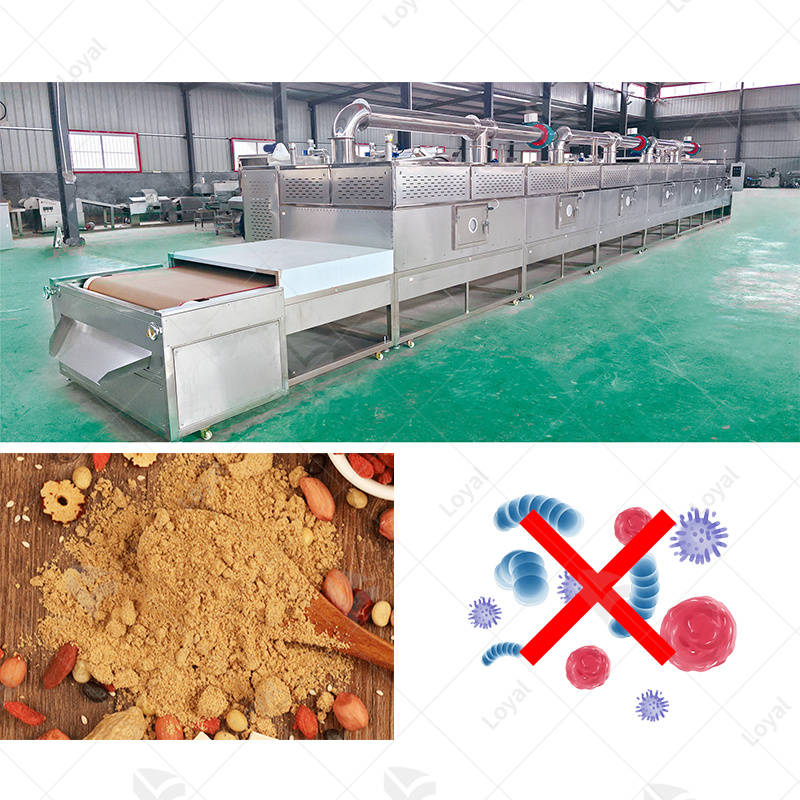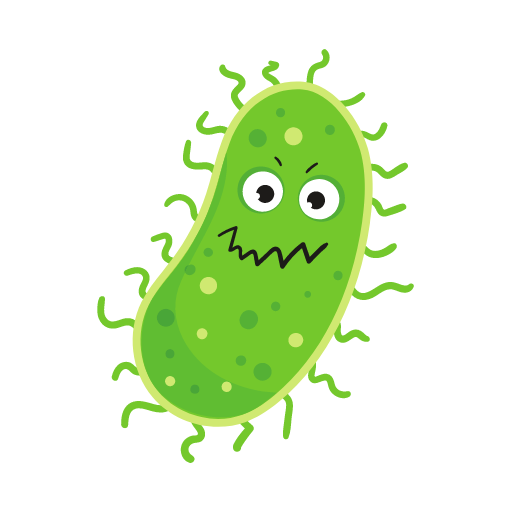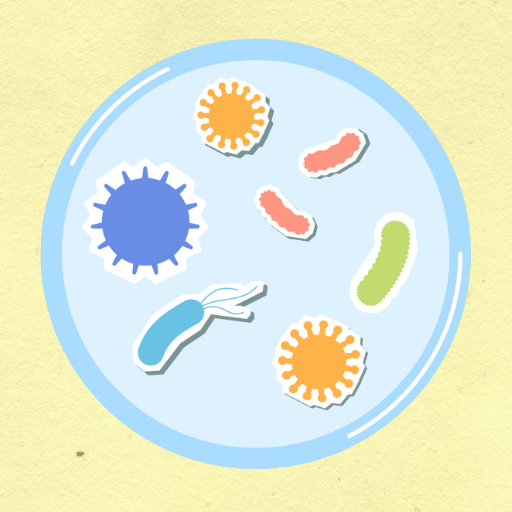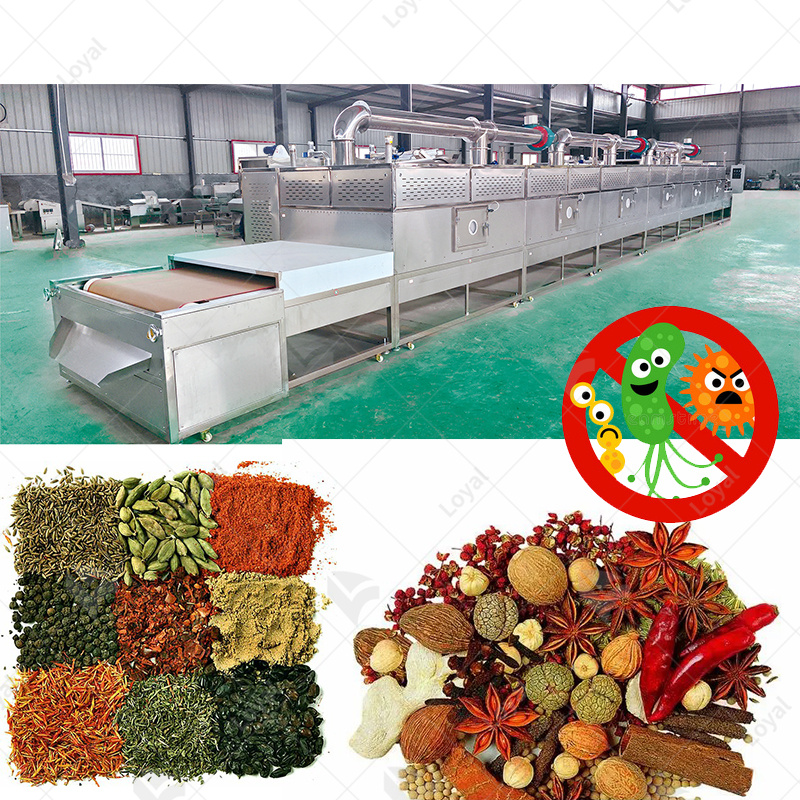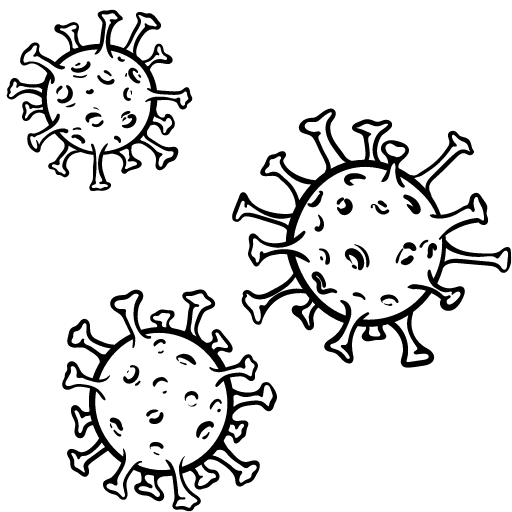In recent times, there has been considerable attention on microwave technology because of its possible uses in various areas, with emphasis being on sterilization and bacterial eradication. This study gives an overall account of the effectiveness of microwave radiation as an antimicrobial agent while dealing with both direct and indirect impacts on bacteria cell. The aim is to review the principles behind microwave interactions with structures like bacterial cells so that we can understand how thermal and non-thermal effects are induced by microwave energy that causes damage or death to the cells. Lastly, some recent research works will be evaluated alongside experimental data, which contains a comprehensive analysis of efficacy, efficiency, and limitations concerning the use of microwaves to sterilize things. Ultimately, this paper seeks to clearly explain how microbial inactivation brought about by microwaves may be applied in different fields, such as food safety, medical instrument sterilization, and wastewater treatment, among others.
Introduction to Microwaves and Bacteria
Microwaves are a type of electromagnetic radiation with wavelengths between one millimeter and one meter. They operate in the frequency range from 300 MHz to 300 GHz. These waves can produce thermal energy by inducing molecular rotation and vibrations, especially polar compounds like water. Bacteria, single-celled microorganisms, have cellular components that are vulnerable to the mechanisms caused by microwave exposure. The rapid oscillation of water molecules within bacterial cells exposed to microwaves results in thermal effects that affect the integrity of cell structures, including membrane integrity and protein activity. As a result, irreversible damages may lead to bacterial cell death. Other experiments also suggested non-thermal impacts involving possible changes in nucleic acid structures and cellular components that further support bacterial inactivation hypothesis. In order to apply microwave technology effectively during sterilization, it is important to understand these interactions.
What are Microwaves?
Microwave radiation is a subset of electromagnetic radiation with wavelengths ranging from one millimeter to one meter which gives a frequency range of about 300 MHz – 300 GHz. Such waves are commonly used as communication technologies, radar or heating processes. The heat-generating mechanism through microwave has an effect on polar molecules, particularly water, for purposes of inducing molecular rotation as well as vibration, hence resulting in thermal energy.
What Are Microwaves?
Microwaves form part of the electromagnetic spectrum, whose wavelength ranges from one millimeter to one meter, corresponding approximately to frequencies between 300 MHz and 300 GHz (Wikipedia). These waves primarily find applications in communication technologies, radar, or heating processes. This process involves molecular rotation and vibration induction on polar molecules such as water, making them emit some heat and thus become thermal.
Noted below are some technical parameters necessary for understanding microwaves:
- Wavelength Range:1 mm – 1 m
- Frequency Range:300 MHz – 300 GHz
- Energy Mechanism: Induction of molecular rotation and vibration in polar molecules, namely water
- Thermal Effects: Rapid oscillation of water molecules causing heat
- Non-thermal Effects: Possible structural alterations in nucleic acids among other cellular components – although still under scrutiny.
These parameters are quite justified due to their fundamental role in microwave heating and microbial inactivation, making them crucial for both theory and practice.
Understanding Bacteria and Microorganisms
Bacteria and microorganisms are ubiquitous entities that vary significantly in terms of structure, function, and environmental adaptability. The unicellularity of bacteria results in various groups depending on the structural characteristics such as Gram-positive and Gram-negative; these two types differ concerning the composition of their cell wall that is detectable through gram staining. Additionally, properties like denaturation and unfolding of proteins or nucleic acid defects during bacterial elimination can be attributed to membrane destruction caused by thermal effects.
Bacteria are miniscule pathogens that live almost everywhere but exhibit great diversity in structure, functioning capacity as well as adaptability towards the environment (Wikipedia). Unicellular organisms known as bacteria fall into numerous categories, such as Gram-positive/negative, which differentiate based on different cell-wall makeup when subjected to Gram-staining. Furthermore, thermal effects caused by such factors lead to protein denaturation, DNA denaturation, membrane disruption, and oxidative stress, among others.
Key technical parameters related to bacterial inactivation by microwaves include:
- Thermal Effects: Generated due to water molecule oscillation at high speed producing heat capable of destroying cellular content.
- Non-thermal Effects: Changes in the structures of nucleic acids among other cell elements being studied for this effect.
- Exposure Time: How long microwave application takes directly correlates with degree of bacterial death rate.
- Power Density: Greater numbers per unit area result into better thermal killing efficiency for microbes considering.
- Frequency: Some frequencies may act more efficiently on bacterial cell structures because of their content.
Such technical parameters are critical in order to maximize the use of microwave for sterilization purposes. This aims at achieving a good balance between killing bacteria efficiently while ensuring target materials remain safe.
Significance of Bacterial Control in Daily Life
Bacterial control is important to prevent the spread of harmful microorganisms that can cause infections, spoil food, and destroy surfaces. There is also need for effective bacterial control strategies in healthcare, food processing and domestic settings. In hospitals, stringent bacterial control measures are put in place to reduce hospital-acquired infections (HAIs) hence preventing patients from getting sick. The parameters that are key in this context include:
- Thermal Effects: Employed during autoclaving and pasteurization to ensure denaturation of bacteria proteins and DNA, hence microbial inactivation.
- Non-thermal Effects: Ultraviolet (UV) radiation and chemical disinfectants (e.g., ethanol, chlorhexidine) disrupt cellular structures leading to death of bacteria.
- Exposure Time: Adequate exposure duration to thermal or non-thermal agents is essential for complete bacterial eradication.
- Power Density: More power densities used in UV disinfection enhances the effectiveness of bacterial killing by providing enough energy to disrupt cell constituents.
In food processing, bacterial control extends shelf life and ensures food safety.
- Thermal Effects: Used for cooking, pasteurization and canning processes where it effectively kills bacteria.
- Non-thermal Effects: Use of bacteriophages or chemical preservatives will help inhibit growth and reproduction of bacteria.
- Exposure Time: Important for attaining desired levels of reduction for bacteria without affecting quality of foods.
- Power Density: Control of power density allows for adequate microbial load reduction while retaining nutrients during irradiation techniques.
At home, cleanliness becomes a crucial aspect of surface cleaning maintenance and proper care on edible materials.
- Thermal Effects: Hot water/steam cleaning destroys the integrity of bacterial cell walls, causing them to burst.
- Non-thermal Effects: Utilize household disinfectants tested against a broad range of bacteria species that prove to be effective.
- Exposure Time: It requires enough contact time with cleaning agents for killing the microorganisms effectively.
- Power Density: Maintain appropriate power density in relation to UV or other radiation-based sterilizers for an effective germicidal action in this case.
Each of these technical parameters must be understood and implemented to achieve comprehensive bacterial control in everyday life, hence improving health and hygiene.
How Microwaves Work to Kill Bacteria
Through thermal effects involving heat, microwaves kill bacteria by disrupting the cellular structures. Water molecules contained in food vibrate quickly when exposed to electromagnetic waves produced by microwaves thereby producing heat that causes an increase in temperature which is lethal to bacteria. This process results in the destruction of bacterial cell walls and protein denaturation leading to microbial functions being rendered inactive. Another reason why the use of microwave could be beneficial as a means for bacterial reduction is due to hot spots localized differently along their passage course. Moreover, the effectiveness of bacterial inactivation relies on various aspects like the starting number of bacteria, how microwaves are spread out within food, and exposure time.
Microwave Heating Mechanism
Microwave heating works under the principle of dielectric heating where microwave frequency electromagnetic waves (usually 2.45 GHz) cause polar molecules such as water within foodstuffs to interact. As these polar molecules oscillate quickly under an alternating electric field, they produce frictional heat. Critical technical parameters affecting efficiency are:
- Frequency and Wavelength: A standard microwave oven uses 2.45 GHz which corresponds approximately to wavelength 12.24 cm optimizing penetration depth and heating efficiency.
- Absorption Coefficient: The high dielectric constant of polar compounds in foods such as water enhances efficient absorption and heat generation through microwaving.
- Penetration Depth: In food materials, this varies from a few millimeters up to several centimeters depending on composition as well as density defined as the depth at which microwave power declines to 1/e (about 37%) from its surface value.
- Power Output: Microwaves have different power settings but generally range from 600 to 1200 Watts; hence, higher settings become more advantageous in terms of faster heating, although there has to be uniform distribution; otherwise, cold or hot spots may result.
- Exposure Duration: The duration at which food stays with microwaves determines how uniformly heated it is necessitating adherence to recommended cooking period for the sake of microbial safety.
Being aware of these parameters enables effective utilization of microwaves to provide safe and reliable bacterial reduction in food products.
Effects of Microwaves on Bacterial Cell Structure
Mostly, microwave radiation affects bacterial cell structures specifically through dielectric heating and distinct electromagnetic interactions. The fast heating results in the oscillation of water molecules inside bacterial cells, thereby causing friction heat, which can bring about cellular membrane damage as well as protein denaturation or disruption of nucleic acids. Temperatures above 60°C are particularly effective because they lead to destabilization and destruction of vital structural components like peptidoglycan within the walls of bacteria cells and lipid bilayers in membranes. In addition, this can cause cytoplasmic contents to coagulate hence making the bacteria inactive. These combined mechanisms contribute towards the observed microbial inactivation by microwaving food products.
Bacterial Killing through Microwaving: Effects of Temperature and Time
Efficiency of bacterial killing by microwave in food is considerably influenced by specific temperature thresholds and duration. Research shows that it is very important to maintain a temperature as high as 74°C (165°F) for at least half-a-minute to eliminate most pathogens such as Salmonella and E. coli effectively. However, higher temperatures, like- above 100°C (212°F), significantly reduce the exposure period required to deactivate bacteria within seconds. Furthermore, uniform heating should be ensured so that there are no cold spots where bacteria can survive; in most cases stirring or turning over the food during heating could achieve this. Therefore, proper microwave based technique with appropriate temperature and enough time ensures safety and effectiveness in eliminating bacteria from food.
Scientific Evidence and Studies
The studies providing evidence on the efficacy of microwave heating in bacteria killing raise the question of its practical applicability. The article titled Thermal resistance of pathogens in selected food cooked at temperature and time range used for home cooking was received by Journal of Food Protection. Also, another one published by University of Georgia showed that microwaving at 74°C (165°F) was enough to decrease bacterial load significantly. Another report, which is a comprehensive review article, is entitled ‘Microwave preservation parameters for ensuring safety and quality’. It mentioned that uniform heat distributions are imperative if all bacteria are to be killed during heating process and identified microwave-safe containers and stirring techniques as means of addressing this problem.
Research Findings on Microwave Sterilization
Research has proven that there can be microbial safety through use of microwave sterilization for several products. For instance, according to USDA study findings; when heated above certain temperatures, microwaves are capable or ridding harmful bacteria from up to 99.99% foods they contain. This position is also backed by World Health Organization, who reiterate in their publication about “…microwaving baby bottles.” Such an approach eliminates hazards linked with burns caused during traditional heating approaches. In addition, the FDA stresses the need to follow the manufacturer’s directions and use microwave-friendly containers so that sterilization can be performed consistently throughout the product. All this information confirms that proper microwave sterilization technique should be employed in order to achieve better results.
Comparison with Other Sterilization Methods
Traditional autoclaving is a common method for sterilizing laboratory and medical equipment unlike microwave sterilization. Autoclave works mainly best only under high conditions where it exposes items such as hospital instruments to steam at approximately 15psi over 121OC (250OF) between 15-20 min, thereby killing all types of cells, including spores. However, autoclaving is a robust technique for use with non-consumable goods due to its stringent temperature and pressure requirements.
High temperatures and the lack of moisture cause dry heat sterilization which is commonly used on items that can be exposed to high temperatures. In this process, things are usually put into heated air at 320OF (160OC) for about two hours. Even though it does not provide as much efficiency as moist heating does, it can only be used on materials that are resistant to heat.
Chemical sterilization using agents such as ethylene oxide (EO) or hydrogen peroxide gas plasma is widely applied in medical science and pharmaceutical industry. Ethylene oxide (EO) sterilization operates between 30C and 60C (86F – 140F) for a duration of three to seven hours; besides being highly effective, EO is toxic and requires tight control. By contrast, hydrogen peroxide works at lower temperatures, approximately 122F (50°C), and has cycle times of about thirty minutes to an hour, making it suitable for sensitive equipment. Nonetheless, chemical methods require sophisticated devices as well as careful safety procedures.
These methods show that microwave sterilization balances out a lot of practicality in term of food fortification if uniform heating parameters are adhered to along with appropriate temperature conditions. This method proves particularly useful during household and commercial cooking where microbial loads need swift solution without necessarily relying on other expensive equipments.
Applications of Microwave Sterilization
Microwave sterilization technology is widely used across sectors, particularly in the food industry. It is also employed to pasteurize and sterilize foods such as ready-to-eat meals, fish and dairy products, ensuring that microorganisms are killed but nutritional qualities and sensory attributes are retained. In medical practice, microwave sterilization is found to be used in disinfection of medical waste, surgical instruments, and other heat-sensitive healthcare products. This reduces the incidences of bacteria and viral infections hence enhancing hygiene standards. Moreover, microwave sterilization is performed by the packaging industry in order to sanitize packing materials thereby elongating product shelf life as well as ensuring consumer safety. These applications illustrate how flexible and effective microwave sterilization can be when used to promote safety or improve quality among many various industries.
Applications in Food Industry
Mostly used in food industry for pasteurization and sterilization of a variety of products is microwave sterilizers. For instance, ready-to-eat meals that need rigorous sterilizations so as to avoid microbial growth benefit greatly from this technology. Uniform heating is achieved by using microwave radiation which eliminates cold spots where pathogens may persistently survive. Some technical parameters that must be maintained during effective sterility include a temperature range between 140°F – 212°F (60°C – 100°C) with exposure times depending on food density and volume ranging from 2 – 10 minutes.
In keeping fish and marine products fresh while at the same time maintaining their nutritional value microwave undertakes a significant role. The operating conditions for these items mostly involve higher than average temperatures ranging around 212°F (100°C) which allow texture degradation avoidance through proper control over cooking duration only. Similarly milk products such as milk or cheese undergo microwave irradiation at temperatures defined by fine-tuning towards approximately 140°F-158°F (60°C – 70°C) thus resulting into optimal microbial reduction without affecting taste or nutrition.
This therefore implies that any slight changes in the packaging technology might lead to compromising food safety and quality across different product segments within the industry.
Medical and Healthcare Uses
The medical field,, as well as healthcare,, are other areas where microwave sterilization is widely applied for decontaminating medical equipment, surgical instruments, or even some types of healthcare waste. The essence of this technique is that microwave radiation can quickly generate heat with uniformity hence render bacteria and other microorganisms nonviable. The major technical parameters here include operating at frequency 2450 MHz with sterilizing temperature being kept between 185°F – 212°F (85°C – 100°C). Exposure times generally range from five to twenty minutes depending on material volume and type of material involved during sterilization.
When using microwaves to clean surgery tools, the temperature must be controlled to a high degree while ensuring homogeneity throughout so that no sensitive instrument is damaged. These parameters are often very stringent; hence, temperatures around 212°F (100°C) may be set, while exposure times must be matched to the specific material properties of the instruments.
Microwave sterilization is an applicable method for effective microbial inactivation without causing environmental contamination when managing medical waste like discarded bandages or injection materials. A typical process-specific temperature ranges from 212°F to 250°F (100°C -121°C), whereas exposure durations depend on the density loading as well as pathogen types.
These criteria demonstrate how versatile and effective microwave sterilization is in medical environments ensuring patient safety through hygienic practices.
Benefits and Advantages
The benefits of using microwaves for sterilization in medical settings are varied. Primarily, it has a fast sterilization cycle time that enhances throughput and efficiency in busy healthcare environments. In microwave sterilization, unlike conventional means, there is consistent and uniform heating which ensures that the entire load attains adequate temperature to effectively kill the microorganisms. Also, this method does not use chemicals that may have harmful residues hence it is eco-friendly. Additionally, these systems require minimal space and can be positioned at various points on different workflow arrangements thereby allowing for flexibility in any place. Moreover, exact control over temperatures and exposure times reduces chances of damaging delicate medical tools thus extending their life spans as well as preserving their qualities.
Efficiency in Killing Pathogens
A wide range of pathogens, such as fungi, bacteria, and viruses, are killed by microwave sterilization efficiently (Ojha et al., 2019). The process involves dielectric heating where the microbial cells’ water molecules absorb microwave energy leading to rapid thermal agitation resulting to cell rupture. These factors greatly determine its efficacy:
- Frequency and Power Output: Standard microwave sterilization operates at a frequency of 2.45 GHz with power outputs ranging from 500 to 1000 watts ensuring that sterility is achieved without compromising most medical instruments’ structural integrity.
- Temperature and Exposure Time: A typical operational range falls between 212°F – 250°F (100°C-121°C). For complete eradication of pathogens an average duration time frame between 5-15 minutes should be maintained depending on microbial load or density.
- Moisture Content: Microwave sterilization effectiveness increases when water is present because it ensures even distribution of heat energy throughout the system (Ojha et al., 2019). To make sure maximum efficacy of the process many scholars suggest minimum moisture levels within loads to stand at about ten percent up to fifteen percent.
Researches done so far including relevant industry standards provide an insight into the reliability of using microwaves for sterilization purposes in medical settings.
Preservation of Nutrients
Another advantage of microwave sterilization is that it helps in preserving the nutritional content of food, a major concern in healthcare and food industries. This quickly heating up ensures that heat-sensitive vitamins such as vitamin C, B5 are not lost as they are destroyed when exposed to conventional high heat methods of sterilization for long periods. These include:
- Thermal Exposure Time: The time taken to expose products to heat is shorter in microwave than other types of sterilizations which result in minimal degradation of nutrients hence reduced nutrient loss.
- Temperature Control: By maintaining temperatures between 212°F – 250°F (100°C-121°C), essential nutrients can be preserved while allowing enough kill rates for microbes avoiding excessive heat that denatures them.
- Energy Distribution: Microwaves evenly distribute energy ensuring all parts of the product receive similar treatment thereby eliminating localized hot spots capable of destroying essential nutrients.
Many credible sources, such as FDA guidelines and numerous peer-reviewed articles, validate the microwave sterilization method as one that effectively destroys microorganisms yet retains nutrients during food processing.
The environment and sustainability
Microwave sterilization is a better option environmentally than traditional means. It uses less energy because the processing time is shorter, thus lowering the entire energy consumption and greenhouse gas emissions. This technique also cuts down on water usage since it does not need significant steam generation as most conventional methods of sterilization do. Additionally, it further reduces thermal exposure thereby decreasing reliance on chemical preservatives that in turn makes food production cleaner and more sustainable. Combined together, all these factors contribute to a reduced carbon footprint, which proves to be microwave sterilization is an environmentally conscious choice associated with contemporary goals of sustainability.
Safety Concerns and Practical Tips
Some safety issues should be considered to make microwave sterilization safe and effective. The first thing to do is to use microwave-safe containers to avoid chemical leaching in foods. Containers made of glass, ceramics, and specific plastics designated as microwave-safe are advised. Metallic containers should be avoided since they cause arcing that can damage the microwave oven.
Microwave sterilization needs proper monitoring to avoid uneven heating leading to incomplete destruction of microorganisms within food materials. This risk can be minimized by using turntables and arranging food evenly in the oven. Users need to clean their microwaves on a regular basis in order to prevent residue accumulation which may cause contamination. Moreover, following manufacturer’s instructions regarding cooking time and power settings is important for ensuring that the sterilization process is efficient but retains the nutritional character of the food product.
For practical purposes, it would be worthwhile buying a microwave with several power settings and a revolving turntable. Additionally, knowing your specific wattage will enable you to set the correct cooking times accurately. Regular maintenance, such as checking for damaged door seals, ensures your microwave’s efficiency and safety over time.
Microwave Cooking Safety Tips
For an effective and safe microwave experience, observe the following safety tips when operating it. Always use the containers labelled as microwave-safe. Avoid using metal objects or aluminum foil in order to prevent sparking and damaging the machine. It is possible to ensure that different areas of food receive equal heating levels by ensuring that one cleans her microwave frequently and appropriately for purposes of preventing food residues from accumulating on its interior surfaces. Additionally, regularly check the signs of damage on the doors and seals of your microwave since a compromised seal can result in radiation exposure. Observe power settings and recommended cooking times as per guidelines given by manufacturer to avoid overheating your food and also ensure that it is safe to eat. Lastly, do not run an empty microwave oven as this can cause damage to its magnetron.
Possible Pitfalls and Misconceptions
Radiation leakage due to damaged or improperly sealed doors represents one of the main risks related with using microwaves. Thus, it is important that door seals are inspected regularly for damages along with other parts of a unit in order to mitigate this risk. Another major danger comes from uneven heating, whereby certain parts may be undercooked, thereby failing to reach temperatures necessary for destroying bacteria that can harm human beings by causing diseases such as salmonella poisoning, which often happens when the wrong types of containers are used or power levels are adjusted wrongly.
There are some myths concerning microwaves’ radiation. One common perception is that microwaves emit harmful radiation causing cancer. However, there is shielding within microwave ovens designed to protect individuals against non-ionizing radiation that is not known to be carcinogenic.A misconception exists which states that microwaving destroys most nutrients inside food items. Studies have shown that nutrient content remains preserved at higher degrees via quick cooking time compared with other methods, exposing them to less heat .
Finally, there is a technical concern regarding microwave oven energy consumption. While generally efficient, high settings over prolonged periods of time can increase energy use. As a point of reference, a typical household microwave operates at about 600 to 1200 watts. This can be mitigated by proper knowledge and usage of power settings. Regularly reading the manufacturer guidelines and ensuring proper maintenance practices will go a long way in reducing these hazards and misconceptions to achieve optimal and safe use of microwave ovens.
Synonyms for Best Practices for Effective Bacterial Control
The microwave cooking with effective bacterial control should be done under several diligent practices. The first is to achieve a safe internal temperature of about 165°F (74°C) which will kill all the pathogenic bacteria in food. This temperature can be checked throughout by use of a food thermometer. Secondly, put a lid or wrap on the food that is microwave-safe as you heat it; this will result in even heating since steam is trapped, thus preventing cold spots where bacteria thrive. Also, one must stir or turn over foods during cooking so that an even distribution of heat is achieved. Further, cleaning the inside of the microwave oven using mild detergent which would prevent cross-contamination from remaining food particles is recommended to individuals. By following these guidelines, consumption of micro waved foods with bacterial contamination can be greatly reduced
Frequently Asked Questions (FAQs)
Q: How effective is a microwave in killing bacteria in food?
A: Microwaves can be used to kill bacteria and keep food safe, but their effectiveness depends on several factors, including the temperature reached and the duration of heating. To ensure food safety, it’s crucial to heat the food to an internal temperature of at least 165 degrees Fahrenheit.
Q: Can microwaves kill bacteria in food evenly?
A: Microwaves have a tendency to cook food unevenly, which can leave cold spots where bacteria can survive. To mitigate this, it’s important to stir food when reheating and use a microwave-safe cover to promote even cooking.
Q: Is it safe to rely solely on a microwave to kill bacteria in leftover food?
A: While using a microwave can effectively reheat and kill bacteria, it is essential to make sure your microwave is functioning correctly and to use it according to the guidelines. Ensuring that food reaches a safe temperature is key for eliminating harmful bacteria.
Q: Does reheating food in a microwave kill all types of bacteria?
A: Reheating food in a microwave can kill many common bacteria, such as Salmonella and Clostridium, but it may not eliminate all types of foodborne pathogens entirely. Consistent and thorough heating to the appropriate temperature is crucial for food safety.
Q: What precautions should I take when using a microwave to kill bacteria in chicken breast?
A: When cooking or reheating chicken breast in a microwave, make sure it reaches an internal temperature of 165 degrees Fahrenheit to kill bacteria. Cutting the chicken into smaller pieces can help ensure even cooking and avoid cold spots.
Q: How does microwave irradiation work in killing bacteria?
A: Microwave irradiation works by producing heat that causes water molecules in the food to vibrate. This heat can kill bacteria and viruses if the food reaches a high enough temperature. However, microwaves don’t always heat food uniformly, so additional precautions are necessary.
Q: What role does microwave technology play in food safety?
A: Microwave technology can improve food safety when used correctly by effectively killing bacteria and viruses in food. Following proper cooking times and temperatures recommended by the food safety and inspection service is critical for maintaining safe food practices.
Q: Can microwaves kill salmonella in food?
A: Yes, microwaves can kill Salmonella if the food is heated to a temperature of at least 165 degrees Fahrenheit and maintained at that temperature throughout. Proper reheating techniques are essential to ensure all parts of the food reach the safe temperature.
Q: Do microwaves make food safe to eat by killing bacteria?
A: Microwaves can make food safe to eat by killing bacteria and viruses when the food is heated sufficiently. It is important to follow guidelines closely to make sure you’re achieving the necessary temperatures to eliminate bad bacteria and foodborne pathogens.
Q: How can I ensure safe food practices when using a microwave?
A: To ensure safe food practices when using a microwave, always cook or reheat food to safe temperatures, use a food thermometer to confirm the food has reached at least 165 degrees Fahrenheit, stir food to prevent cold spots, and follow manufacturer instructions to make sure your microwave is operating effectively.














